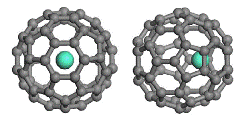Department of Chemistry
Date of this Version
6-1-2001
Abstract
Molecular dynamics simulations of nucleation of a supersaturated Lennard-Jones vapor in slit nanopores are carried out. In this study we extend a previous work [K. Yasuoka, G. T. Gao, and X. C. Zeng, J. Chem. Phys. 112, 4279 (2000)] in that the walls of the slit are treated as actual atomic walls serving as both the confining solid surfaces and a thermostat. The walls are fixed in place in a fcc lattice structure and wall atoms are subjected to a stiff biharmonic potential thereby bounded to lattice sites. The two walls of the slit have an identical surface [fcc (100)], but different strength of attractive interaction with the vapor particles—one is strongly adsorbing and another is weakly adsorbing. Heterogeneous nucleation of the supersaturated vapor in the slit is investigated and events of nucleus formation are monitored in real time. A comparison with the previous simulation (using rigid structureless walls) leads to useful insight into the influence of the wall model to the nucleus formation. In particular, it is found that although the adsorbed particles on the structureless wall diffuse faster than those on the atomic wall, the rate of nucleus formation on the structureless wall is actually about one order of magnitude lower. A detailed analysis of particle and cluster-formation flux indicates that the rate of nucleus formation on the wall is more sensitive to the kinetics of adsorption of gas particles onto the wall than the diffusion rate of adsorbed particles. The higher flux of cluster formation on the atomic wall is apparently due to the higher rate of deposition of monomers onto the wall.


Comments
Published by American Institute of Physics. J. Chem. Physics VOLUME 114, NUMBER 21, 1 JUNE 2001. ©2001 American Institute of Physics. Permission to use. http://jcp.aip.org/.